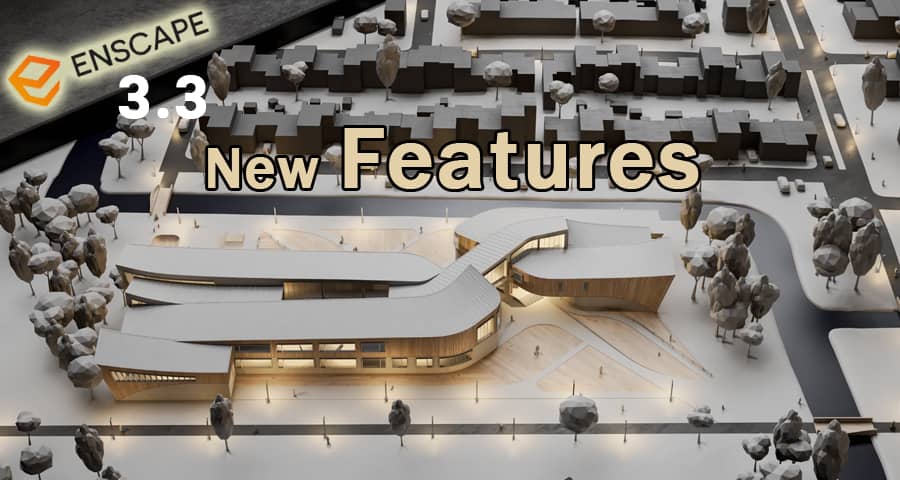In the latest version of Enscape 3.3 for SketchUp, you can see the magic in real time, and it is absolutely stunning. There has been a radical change in the way designers create its with Enscape lighting SketchUp and Enscape rendering SketchUp. It’s time to update your version of Enscape for SketchUp to version 3.3.
In what ways does Enscape for SketchUp help you?
In the architecture, engineering, and construction industry, Enscape is an essential tool for the use of real-time rendering and virtual reality. Enscape is an essential tool for the creation of these projects.
By combining Real-Time Rendering and Virtual Reality, you will be able to enhance your designs, streamline your workflow, and bring your imagination to life.
By integrating it directly into your modeling tools, you can focus on creating, designing, and building. The latest version of Enscape works seamlessly with the latest version of SketchUp.
We are going to discuss about the functionality of Enscape 3.3 in this article.
What are the benefits of using Enscape with SketchUp?
Enscape has many different types of use, especially in its newer version. The benefits and the functions are mentioned below:
- With Enscape, you will be able to create video walkthroughs, flythroughs, animations, and even virtual experiences quickly and easily. Having this kind of experience alone is invaluable since it is exactly these kinds of experiences that make a difference to clients, inspire the right decisions, and help push approvals through faster due to its ability to convince them.
- The use of virtual reality provides you and others with the opportunity to explore designs via inspirational realism. To experience spectacular visuals while walking or flying through your project, connect a VR headset such as the Oculus Rift S or HTC Vive.
- Whether it is designers, clients, or anyone else, you have a wide variety of export options that make it very easy to collaborate with others, no matter who they are. No special software or technology is needed for them to understand it. You can create atmosphere and character using hyper-realistic lighting, thanks to an amazing selection of atmosphere settings. It’s endlessly customizable, from the cloud cover to the time of day.
- The new version of Enscape 3.3 even offers a suite of workflow tools that can be used to collaborate annotations, so that people can make changes, suggest materials, highlight an issue, and do whatever is necessary to complete the project. In order to do your design work effectively and efficiently, it is important to keep your progress in the right context, to keep everyone involved informed, and to communicate with them as effectively as possible.
Using Enscape in SketchUp for lighting
It is just as amazing to see the Enscape lighting in SketchUp style. The Enscape Objects window provides access to lights since SketchUp has no own lights. With SketchUp, you can access Extensions from the menu, or Enscape from the ribbon.
Light sources can be added to models in the following way. This is a very simple project, which makes it really inspirational. Simply select Extensions > Enscape > Enscape Objects from SketchUp. Once you have got your hands on it, you can choose from five different light sources: Sphere light, Spotlight, Rectangular (Rect) light, Disk light, and Line light.
Spot Light
Four clicks are required to position a spotlight, with the first two fixing the end point and the next two setting the cone’s orientation. Click to choose the surface or axis the light source is based from to position a spotlight. Move the mouse to specify the direction and axis that you want the light to travel along, and then click once more to specify the light source.
Line Lights
Fluorescent tube lights are represented as line lights, which are linear lights. You may adjust the length, and they are available in 3m lengths. Once more, put them using the two-click method. From there, you may define and rotate them whatever you desire. You can rotate using the native rotation controls in SketchUp or the control points.
Sphere Light
In an Omni light, rays radiate from a single point equally in every direction. If you want to place the light, you will first need to choose the surface or axis from which the light is based, then you will need to place the light after selecting the surface or axis. Once you have adjusted the intensity of the light, you will be able to see the difference.
Colored Lights
There is a feature in SketchUp called Paint Bucket that allows you to color lights. Choosing the right colour from the Material Editor, applying it, then adjusting it directly in the Enscape window is as simple as that.
Download Enscape for SketchUp
You can use self-illuminating materials if the Enscape Objects window does not include self-illuminating objects. It is either necessary to add the keyword ‘Emissive’ to the material name, or you can go through the Material Editor, which gives you more control over the material’s luminance, intensity, and color. The Self-illuminated material type is selected here. It is where the object material type is changed.
Lastly, Enscape also provides support for optimizing and cleaning models by removing unnecessary geometry and materials, resulting in a lovely clean model that you are sure to enjoy.


